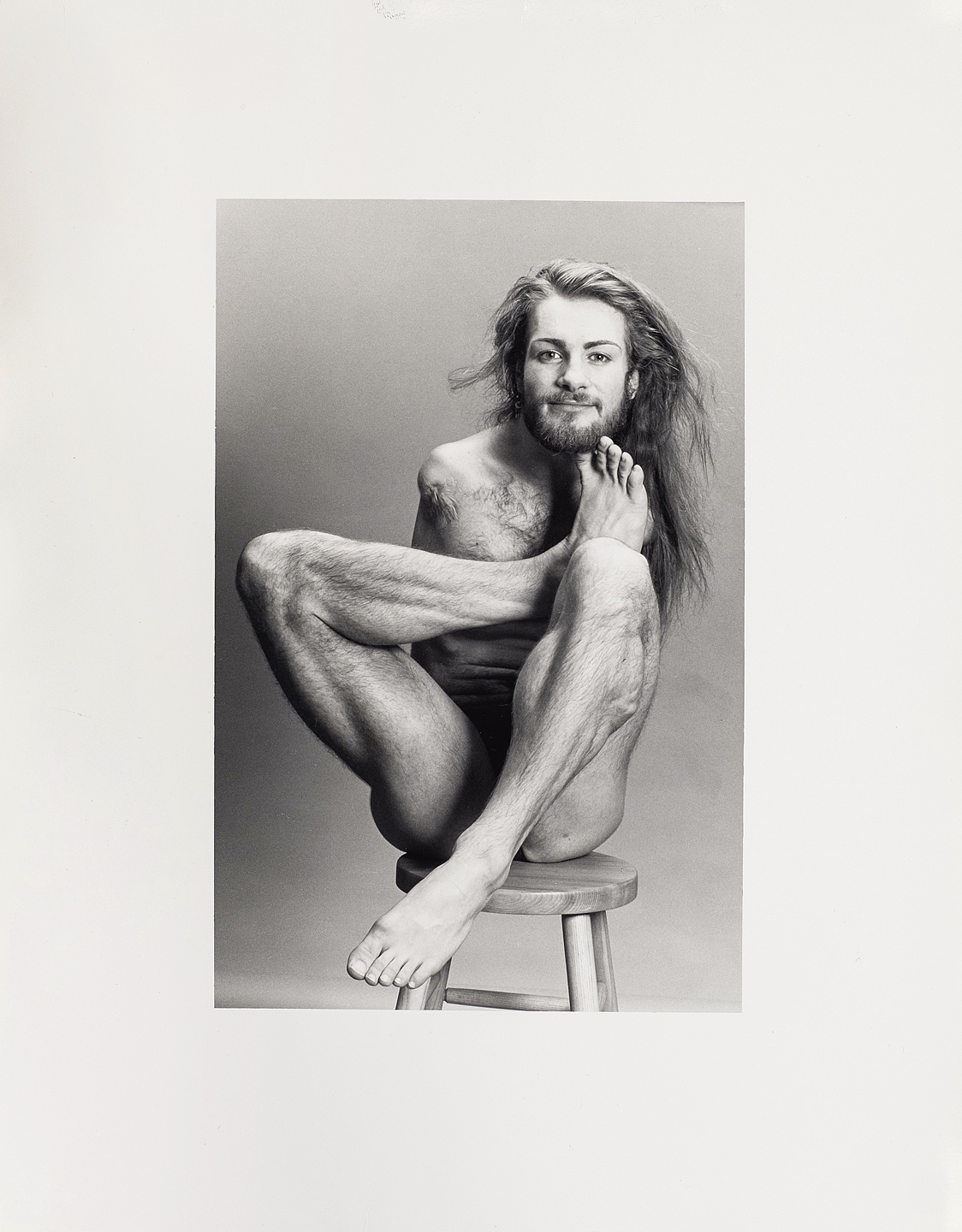Lives and Works of Lorenza Böttner

Lorenza Böttner, untitled (n. d.), black-and-white photograph, 24 × 22 cm. All works Provate Collection
Lorenza Böttner (1959–1994) was an artist who held an acute, embodied relationship with transformation. She transformed a painting practice into a performance art that took to the streets and made public space a stage for a politicized bodily difference. In part, her practice is aligned with the tradition of mouth-and-foot artists who make a living from painting in public. Yet, she also subverted this tradition through her themes and a conceptual language that cut through and spoke to political and sexual issues.
Lorenza, originally named Ernst Lorenz Böttner, was born in 1959 into a family of German origin in Punta Arenas, Chile. At the age of eight, he was electrocuted when climbing up a pylon, resulting in both arms having to be amputated below the shoulder. He returned to Germany with his mother in 1973 to undertake a series of plastic surgery operations and moved to Lichtenau, a city near Kassel. Böttner grew up being considered “disabled” and suffered the same internment and exclusion as the so-called Contergan children, who were born with morphological differences from in-uterus effects of the drug thalidomide.
Böttner, however, resisted and refused prosthetic arms. S/he chose to transform her situation, developing an impassioned interest for classical ballet, jazz, and tap dancing, and learning to paint with her feet and mouth. S/he studied painting at the Kassel School of Art and Design, graduating with a thesis entitled “Behindert?” in which s/he questioned the category of disability and explored the genealogy of mouth-and-foot painters. In Kassel, a double process of subjective and artistic self-construction began. Firstly, Lorenz decided to use the name Lorenza, affirming an openly transgender feminine position; Lorenza’s drawings and self-portraits as a woman, feminine clothes designed for armless bodies, and photographic sequences documenting this process of transformation functioned as performative technologies for creating an armless-transgender subjectivity (as seen in the Venus de Milo performance, first enacted in Kassel in 1982, later taken to New York and San Francisco). Secondly, if medical discourse and modes of representation aim to desexualize and degender the impaired body, Lorenza’s performance work eroticized the trans-armless body, endowing it with sexual and political potency.
Lorenza went on to travel extensively, presenting hundreds of street performance-paintings. She was affiliated with the Disabled Artists Network, and rallied for the recognition of mouth-and-foot art by art history and museum institutions. She also actively opposed the processes of desubjectification, incapacitation, desexualization, and castration that modern normalizing societies reserve for the bodily other. In 1988, Lorenza moved to Barcelona, and in 1992 became the living embodiment of Petra, the controversial Paralympic mascot designed by Mariscal. She died in 1994 from HIV-related complications.
Lorenza’s dissident transgender body became a living political sculpture, a trans-armless sculptural manifesto. Surpassing categories of abstract expressionism or the feminist tradition of performance art, Lorenza painted and danced, in the streets, on paper or canvas, claiming the right to exist and create in a transgender armless body.

Kain Karawahn, Lorenza Böttner, untitled (n. d.), black-and-white photograph mounted on cardboard, image: 35.5 × 27.9 cm. © VG Bild-Kunst, Bonn 2019

Lorenza Böttner, untitled (n. d.), three black-and-white photographs mounted on cardboard, 34.9 × 45.7 cm overall

Lorenza Böttner, untitled (n. d.), three black-and-white photographs mounted on cardboard, 34.8 × 45.5 cm overall

Lorenza Böttner, untitled (1985), pastel on paper, fifteen sheets joined with adhesive tape, sheets: 23.5 × 35.5 cm each, approx. 114 × 104 cm overall

Kain Karawahn, Lorenza Böttner, untitled (n. d.), six black-and-white photographs mounted on cardboard, 34.7 × 49.8 cm overall. © VG Bild-Kunst, Bonn 2019

Article on the 1992 Barcelona Paralympics featuring image of Lorenza as Petra, El Observador, September 4, 1992

Portraits from Studio Sepp Bär, Kassel (ca. 1978), two color photographs in folder, photos: 15 × 11 cm each




